中国历史英文课件
- 格式:ppt
- 大小:16.39 MB
- 文档页数:5
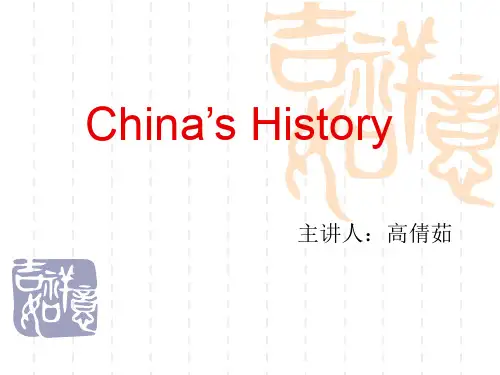

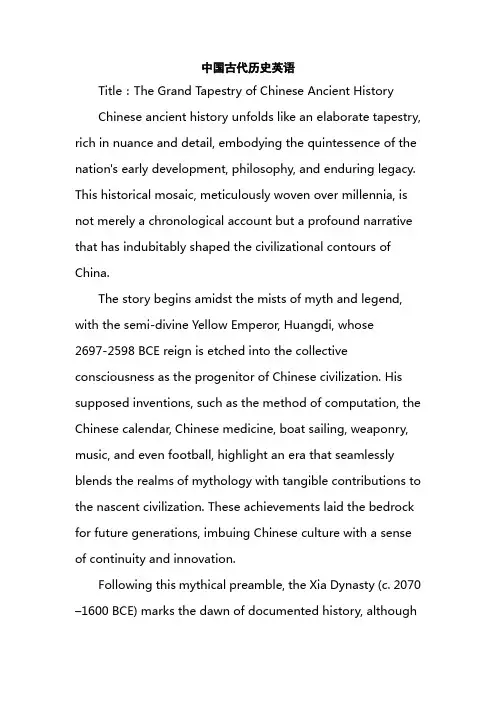
中国古代历史英语Title:The Grand Tapestry of Chinese Ancient HistoryChinese ancient history unfolds like an elaborate tapestry, rich in nuance and detail, embodying the quintessence of the nation's early development, philosophy, and enduring legacy. This historical mosaic, meticulously woven over millennia, is not merely a chronological account but a profound narrative that has indubitably shaped the civilizational contours of China.The story begins amidst the mists of myth and legend, with the semi-divine Yellow Emperor, Huangdi, whose2697-2598 BCE reign is etched into the collective consciousness as the progenitor of Chinese civilization. His supposed inventions, such as the method of computation, the Chinese calendar, Chinese medicine, boat sailing, weaponry, music, and even football, highlight an era that seamlessly blends the realms of mythology with tangible contributions to the nascent civilization. These achievements laid the bedrock for future generations, imbuing Chinese culture with a sense of continuity and innovation.Following this mythical preamble, the Xia Dynasty (c. 2070–1600 BCE) marks the dawn of documented history, althoughits existence remains intertwined with myth due to a dearth of archaeological evidence. Still, it represents a pivotal transition from society grounded in legend to one anchored in historical documentation, setting the stage for the Shang Dynasty (c. 1600–1046 BCE). The Shang are renowned for their advancements in writing, divination, and urban planning, notably through the intricacies of the oracle bones script and the majestic walls of Anyang. It is during this period that the blueprint for subsequent dynastic rule and cultural orthodoxy began to crystallize.The subsequent Zhou Dynasty (1046–256 BCE) introduced a paradigm shift with its feudal system, wherein power was decentralized amongst vassal states, each overseen by kings directly descended from the Zhou rulers. This era spawned the "Spring and Autumn" (770–476 BCE) and "Warring States" (475–221 BCE) periods, characterized by intense political fragmentation and intellectual ferment. It heralded the'Hundred Schools of Thought', including Confucianism, Daoism, and Legalism, which would leave an indelible mark on Chinese philosophical and ethical thought.The year 221 BCE marked the zenith of this turbulence with the Qin Dynasty's ascendancy, under whose brief yetimpactful rule, Emperor Qin Shi Huang orchestrated the unification of China. His legacy includes the iconic Great Wall, the standardization of currency, weights, and measures, and the establishment of a centralized imperial bureaucracy –pivotal elements that underscored the notion of a singular, cohesive empire.The succeeding Han Dynasty (206 BCE–220 CE) expanded upon this unification, ushering in a golden age characterized by the Silk Road's inauguration, which facilitated cultural and commercial exchanges with the Western world. The Han emperors' governance models, such as the imperial examination system for selecting bureaucrats, became blueprints for future administrations, reinforcing the ideals of meritocratic governance and scholarly excellence.As one delves deeper into the annals of China's ancient past, the intricate interplay of governance, culture, and innovation becomes evident. The Tang (618–907) and Song (960–1279) dynasties epitomize this interchange, showcasing artistic flourishes in poetry, porcelain, and painting, while also witnessing technological marvels like the invention of gunpowder and the compass. These eras underscore the synergy between cultural prowess and scientific ingenuity thathas come to define Chinese civilization.In retrospection, Chinese ancient history is far more than a chronological recitation; it is a testament to human ingenuity, philosophical depth, and unwavering perseverance. Each epoch, from the myth-laden origins to the zeniths of cultural and scientific achievements, weaves a continuous narrative that has indelibly shaped not only China but also the broader tapestry of global history. As one reflects upon this grand historical saga, it becomes evident that the echoes of the past continue to resonate within the heart of modern China, fostering a deep-seated pride and a collective memory that transcends the passage of time.。


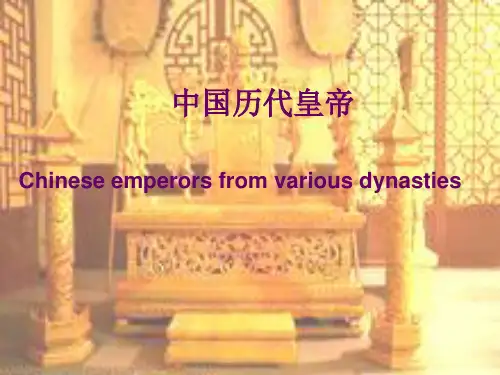
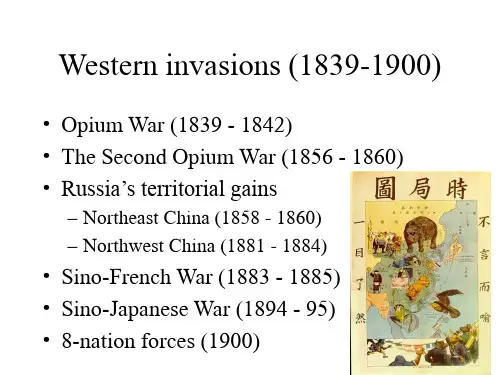

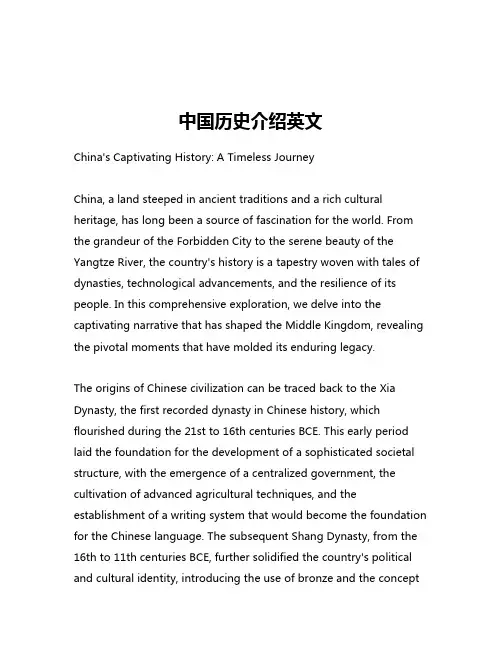
中国历史介绍英文China's Captivating History: A Timeless JourneyChina, a land steeped in ancient traditions and a rich cultural heritage, has long been a source of fascination for the world. From the grandeur of the Forbidden City to the serene beauty of the Yangtze River, the country's history is a tapestry woven with tales of dynasties, technological advancements, and the resilience of its people. In this comprehensive exploration, we delve into the captivating narrative that has shaped the Middle Kingdom, revealing the pivotal moments that have molded its enduring legacy.The origins of Chinese civilization can be traced back to the Xia Dynasty, the first recorded dynasty in Chinese history, which flourished during the 21st to 16th centuries BCE. This early period laid the foundation for the development of a sophisticated societal structure, with the emergence of a centralized government, the cultivation of advanced agricultural techniques, and the establishment of a writing system that would become the foundation for the Chinese language. The subsequent Shang Dynasty, from the 16th to 11th centuries BCE, further solidified the country's political and cultural identity, introducing the use of bronze and the conceptof the Mandate of Heaven, which would shape the dynastic succession for centuries to come.The rise of the Zhou Dynasty, from the 11th to 3rd centuries BCE, marked a significant turning point in Chinese history. This era witnessed the flourishing of Confucianism, a philosophical system that would become deeply ingrained in the fabric of Chinese society, emphasizing the importance of social harmony, filial piety, and the role of the individual within the larger societal structure. The Zhou Dynasty also saw the emergence of the Warring States period, a tumultuous era of political fragmentation and military conflict that ultimately paved the way for the unification of China under the Qin Dynasty in 221 BCE.The Qin Dynasty, though relatively short-lived, left an indelible mark on Chinese history. Under the rule of the first emperor, Qin Shi Huang, the country was unified, a standardized system of weights and measures was introduced, and the construction of the iconic Great Wall began. The Han Dynasty, which followed from 206 BCE to 220 CE, further solidified China's position as a global power, with the expansion of its territory, the flourishing of trade along the Silk Road, and the development of a sophisticated bureaucratic system that would serve as a model for future dynasties.The subsequent centuries witnessed the rise and fall of numerousdynasties, each leaving its unique imprint on Chinese culture and society. The Tang Dynasty, from 618 to 907 CE, is often regarded as the golden age of Chinese civilization, marked by advancements in art, literature, and the sciences. The Song Dynasty, from 960 to 1279 CE, saw the emergence of groundbreaking technological innovations, such as the compass, gunpowder, and the printing press, which would have far-reaching global implications.The Ming Dynasty, from 1368 to 1644 CE, is renowned for the construction of the Forbidden City in Beijing, as well as the voyages of the famous explorer Zheng He, who led a series of expeditions that extended China's influence across the Indian Ocean. The Qing Dynasty, the last imperial dynasty, ruled from 1644 to 1912 CE, and is remembered for its cultural and artistic achievements, as well as its eventual decline in the face of Western imperialism and the rise of nationalist movements.The 20th century marked a pivotal turning point in Chinese history, with the establishment of the People's Republic of China in 1949 under the leadership of Mao Zedong. This era witnessed significant social and economic transformations, including the implementation of communist policies, the Great Leap Forward, and the Cultural Revolution. In the decades that followed, China has undergone a remarkable transformation, emerging as a global economic powerhouse and a leading force in the international community.Throughout its long and storied history, China has demonstrated an unparalleled resilience and adaptability. From the ancient dynasties to the modern era, the country has consistently reinvented itself, embracing new ideas and technologies while preserving its rich cultural heritage. As the world continues to grapple with the challenges of the 21st century, China's enduring legacy serves as a testament to the enduring strength and ingenuity of the Chinese people, and a reminder of the enduring influence of this remarkable nation on the global stage.。
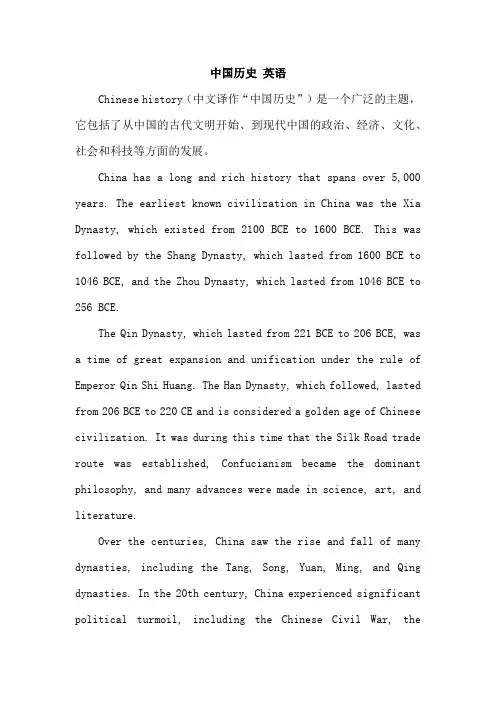
中国历史英语Chinese history(中文译作“中国历史”)是一个广泛的主题,它包括了从中国的古代文明开始、到现代中国的政治、经济、文化、社会和科技等方面的发展。
China has a long and rich history that spans over 5,000 years. The earliest known civilization in China was the Xia Dynasty, which existed from 2100 BCE to 1600 BCE. This was followed by the Shang Dynasty, which lasted from 1600 BCE to 1046 BCE, and the Zhou Dynasty, which lasted from 1046 BCE to 256 BCE.The Qin Dynasty, which lasted from 221 BCE to 206 BCE, was a time of great expansion and unification under the rule of Emperor Qin Shi Huang. The Han Dynasty, which followed, lasted from 206 BCE to 220 CE and is considered a golden age of Chinese civilization. It was during this time that the Silk Road trade route was established, Confucianism became the dominant philosophy, and many advances were made in science, art, and literature.Over the centuries, China saw the rise and fall of many dynasties, including the Tang, Song, Yuan, Ming, and Qing dynasties. In the 20th century, China experienced significant political turmoil, including the Chinese Civil War, theCultural Revolution, and the establishment of the People's Republic of China in 1949.Today, China is a major world power with a rich cultural heritage that continues to influence the world in many ways.。